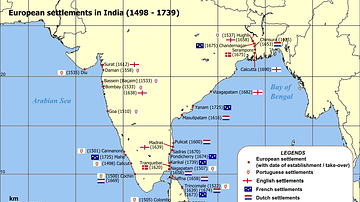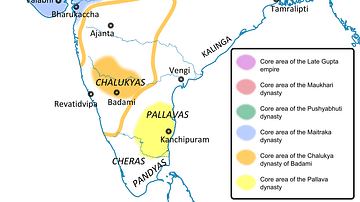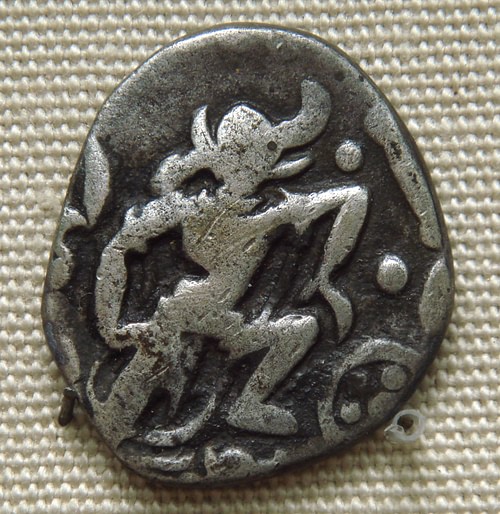
The Gurjara-Pratiharas, or simply, the Pratiharas (8th century CE - 11th century CE) held their sway over western and northern India. This dynasty saw its fortunes rising under Nagabhata I (730–760 CE) who successfully defeated Arab invaders. Bhoja or Mihira Bhoja (c. 836-885 CE) was the most well-known king of this dynasty. The Pratiharas were known chiefly for their patronage of art, sculpture and temple-building, and for their continuous warfare with contemporary powers like the Palas (8th century CE - 12th century CE) of eastern India and the Rashtrakuta Dynasty (8th century CE - 10th century CE) of southern India.
Rise of the Gurjara-Pratiharas
In 647 CE, the fall of the Pushyabhuti Dynasty based at Kanyakubja (modern-day Kannauj city, Uttar Pradesh state) under Harshavardhana (606-647 CE) led to chaos and political instability. Many kingdoms rose and fell, and those which came to dominate were those of the Pratiharas, the Palas of eastern India and the Rashtrakutas of southern India. Kanyakubja was ruled at the time by the Ayudha dynasty (c. 9th century CE).
The origins of the Gurjaras and particularly the Gurjara-Pratiharas are still a matter of debate. The Gurjaras are variously seen as a foreign people gradually assimilated into Indian society, or as the local people who belonged to the land called Gurjara (Gurjaradesha or Gurjaratra), or as being a tribal group. The Pratiharas, who derived their name from the word pratihara (Sanskrit: “doorkeeper”) are seen as a tribal group or a clan of the Gurjaras. In the epic Ramayana, Prince Lakshmana acted once as a doorkeeper to his elder brother King Rama. Since Lakshmana was regarded as their ancestor, the Pratiharas adopted this title. Various other Gurjara families started out as local officials and eventually set up small principalities to the south and east of the area of Jodhpur in modern-day Rajasthan state.
The Pratiharas rose to fame in the late 8th century CE after successfully resisting Arab invaders. Besides inscriptions, the sculpture created and monuments built during their reign provide valuable evidence of their times and rule. Primary literary sources include the accounts of Arab merchants who visited India in this period like Suleiman (c. 9th century CE) who visited India in the 9th century CE and left behind an account of his travels, and al-Masudi (c. 10th century CE), who visited Gujarat in 915-16 CE. All these writers refer to the Paratihara Kingdom as al-Juzr (derived from the Sanskrit Gurjara) and attest “to the great power and prestige of the Pratihara rulers and the vastness of their empire” (Chandra, 10).
Pratihara Kings
Nagabhata I
He was the first significant king of the dynasty and because of his achievements that included the defeat of the Arabs, his line came to overshadow other Gurjara-Pratihara families. He fought against the Rashtrakutas, though unsuccessfully. He was succeeded by his nephew Kakustha, who in turn was followed by his brother Devaraja. These two ruled in the period c. 760-775 CE.
Vatsaraja
Able to defeat the Bhandi or Bhatti clan, Vatsaraja (775-800 CE) gained sway over most of central Rajasthan. He then dabbled in Kanyakubja politics, defeated the Palas and secured the throne for his Ayudha nominee. Dhruva Rashtrakuta dealt him a serious blow, capturing the insignia of royalty that Vatsaraja had captured from the Palas, and drove him to seek shelter in the deserts of Rajasthan.
Nagabhata II
Vatsaraja's son Nagabhata II (800-833 CE) tried to restore the lost fortunes of the dynasty. He subdued the kingdoms of Sindh (now in present-day Pakistan) and those in eastern India and later defeated the Palas. His further conquests were over the kings ruling different portions of Gurjaradesha in western India, including the Arabs. Nagabhata engaged in conflict with the Rashtrakutas over the control of Gujarat and was eventually defeated by the Rashtrakuta Govinda III (793-814 CE), losing thereby south Gujarat and Malwa. After a time, able to regain his strength, he managed to recover some of his lost territories. He also captured Kanyakubja, ending the Ayudha rule. This city now became the Pratihara capital. He was succeeded by his son Ramabhadra (833-836 CE), whose rule saw some territorial recovery.

Bhoja or Mihira Bhoja
Grandson of Nagabhata II, he ruled for nearly 50 years. Though initially defeated by the Palas, Rashtrakutas, and the Kalachuris, he managed to gather his forces and launch a counterstrike. He defeated the Palas, and possibly even the Rashtrakutas with the help of his Chedi and Guhila feudatories. He managed to annex many parts of the Pala Empire in eastern India and recovered territories in Gujarat, Rajasthan and Madhya Pradesh, thus extending his empire to a considerable extent.
Mahendrapala I
Mahendrapala I (885-910 CE) maintained the empire established by his father Bhoja and made fresh conquests in the east. He lost to the king of Kashmir and ceded to him some territories in Punjab. His death was followed by a civil war between his son Mahipala and his half-brother Bhoja II.
Mahipala I
Mahipala I (c. 912-944 CE) managed to secure the throne but was defeated by the Rashtrakutas, which enabled the Palas to take advantage of the situation and retake some of their former territories from the Pratiharas. Mahipala tried to recover from these losses and did regain some lost lands but his plans of conquest were checked in the later years once more by the Rashtrakutas.
Mahendrapala II (c. 944-948 CE) and his successors did not contribute anything significant in their reigns. These kings ruled more like petty kings not much involved in the affairs of the day.
Wars with the Palas & the Rashtrakutas
"The expansion of the Gurjara-Pratihara kingdom involved constant conflicts with other contemporary powers such as the Palas and the Rashtrakutas" known as the tripartite struggle (Singh, 658). Much of it had to do with the control over Kanyakubja as "since the days of Harsha, Kanauj was considered the symbol of sovereignty of north India…control of Kanauj also implied control of the upper Gangetic valley and its rich resources in trade and agriculture" (Chandra, 8).
The Ayudhas ruling Kanyakubja were deemed to be weaklings, and the Palas intervened in their politics, supporting one candidate to the throne, and treating the 'king' there as a feudatory. The Pratiharas, enemies of the Palas, thus had the excuse to attack Kanyakubja (also known as Mahodaya at the time) and support their own candidate to kingship, and fight the Palas on their behalf as Vatsaraja did.
The Pratiharas met more than their match in the Rashtrakutas, who frustrated their attempts to control the upper Gangetic valley and Malwa. The enmity had begun over the control of Malwa and Gujarat “as early as the middle of the eighth century AD when the Rashtrakuta and Gurjara-Pratihara empires were both just founded” (Sircar, 53). The Rashtrakuta emperors Dhruva Dharavarsha (780-793 CE) and Govinda III (793-814 CE) defeated them. Al-Masudi “refers to the Rashtrakuta-Pratihara enmity that was the characteristic feature of the epoch” (Tripathi, 325).
The Rashtrakutas would however never stay to control the north; they would come and go, creating much nuisance for the Pratiharas and all that they had achieved. Historian KM Munshi refers to the Rashtrakutas coming “like a whirlwind from the south” and destroying the Partihara gains. He observes: “With indomitable energy the Pratiharas would then restore the imperial fabric, but equally often the Rashtrakutas, having subdued the south, would march northward to destroy what had been built” (Munshi, 84).
Dhruva's victory over Vatsaraja enabled the Palas to assert their prominence once more and to install their own nominee on the Kanyakubja throne. However, despite defeats by the Rastrakutas, Nagabhata II and later Bhoja rebuilt their empire with Kanyakubja becoming and remaining the Pratihara capital. The Rashtrakutas continued to engage with and defeat successive Pratihara kings well into the 10th century CE.
Geographical considerations also dictated the hostilities between these far-flung kingdoms. The control over the areas connected by the Ganges river, “the highway of traffic linking up all the country from Bengal to mid-India” (Tripathi, 301) was crucial for any kingdom in order to achieve greater prosperity in terms of commerce and economy. Similarly, the need to control south-western trade routes and seaborne commerce led the Pratiharas to retain control of Gujarat. Geographically far off from their base areas in the south, the Rashtrakutas could not afford to stay for long in the north. Much of their campaigns were of the nature of raids, and carried out for the sake of prestige, for obtaining booty, the desire to garner imperial glory and establish their own pre-eminence over the predominant dynasties in India.
Decline
After Bhoja, the military power of the Pratiharas declined, and they suffered defeat after defeat under successive kings. The Rashtrakutas dealt severe blows in the early 10th century CE when Indra III (915-928 CE) defeated Mahipala and completely devastated Kanyakubja and when Krishna III (939-967 CE) invaded again in 963 CE.
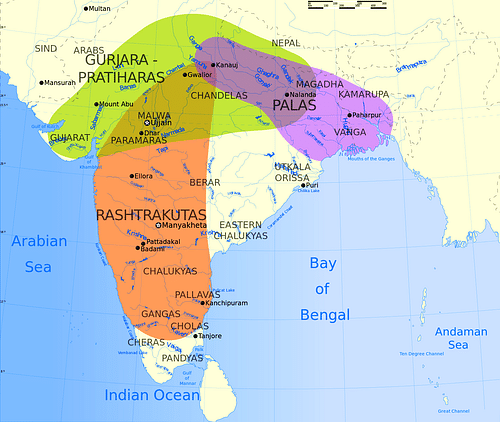
The Rajput feudatories of the Pratiharas were another threat as “the descendants of Mihira Bhoja had little of Gurjaradesha left in their hands, for every one of the feudatories was seeking greater power for himself at the cost of his suzerain” (Munshi, 151). Owing to the political fabric in India at the time, nearly every king when subdued would accept to be a vassal of the conqueror, but would ceaselessly try to gain independence and go for it at the slightest opportunity. The Pratiharas were no exception. The weakening of the central power and attacks on the capital made their feudatories and provincial governors assertive and dying to declare independence. As a result, the empire disintegrated and was reduced to a kingdom covering only the area around Kanyakubja.
The Pratihara kingdom continued its existence in a subdued fashion till the early 11th century CE when it was finally conquered by the Ghaznavid Turks. Their control was however temporary and this area was taken over by Indian rulers, most notably of the Gahadavala Dynasty (c. 1080-1194 CE).
Government
In terms of administration, much of the Gupta Empire's (3rd century CE - 6th century CE) and Harshavardhana's ideas and practices were retained. The king was supreme and was aided by a variety of ministers and officials. Many minor kings and dynasties ruled as vassals of the king and were expected to be loyal, pay a fixed tribute to the king, conclude matrimonial alliances with the royal family and supply troops when needed. Some areas were administered directly by the centre and were divided into provinces (bhukti) and districts (mandala or vishaya). They were, respectively, governed by a governor (uparika) and a district head (vishayapati), who were tasked with collecting land revenue and maintaining law and order with the help of the army units stationed in their areas. The village, as in earlier times, remained the basic unit of administration which was carried out by the headman and other officials, all paid through land grants. However, many vassals always looked forward to becoming independent and often fought against the king like the Paramaras and the Chandellas of modern-day Bundelkhand region (lying in the states of Uttar Pradesh and Madhya Pradesh).

Despite incessant warfare, the Pratiharas managed to provide stability to their subjects and patronized arts and literature. Al-Masudi says that Juzr had 18,000,000 villages, cities and towns and was about 2000 km in length and 2000 km in breadth. The poet Rajashekhara was associated with Mahendrapala and Mahipala and left behind many works of note. Many Hindu temples and buildings were built, many of which survive even today. “Under the two centuries of Gurjara-Pratihara rule till 1019 AD, the city of Kanauj became one of the greatest centres of art, culture and commerce in the Indian subcontinent” (Sircar, 13).
The loss of Gujarat and the subsequent loss of overseas trade particularly to western Asia affected economic conditions. Billon coins, or coins made from alloys and a majority of base metal content, were issued in the Ganga valley.
Army
“The incessant warfare during the period indicates the importance of coercive power and military might in the politics of the time” (Singh, 551). The Pratiharas, like all other kingdoms in the period, maintained a core army supplemented by mercenaries, allied and feudatory troops.
The Pratiharas were well-known for their cavalry. Horses were imported from Central Asia and Arabia and constituted an important item of Indian trade in this time period. According to al-Masudi, the army had four divisions of 7 million to 9 million each. The northern army was deployed against the Muslims, the southern army against the Rashtrakutas and the eastern against the Palas. The elephants were only 2000 in number, thus showing that the Pratiharas focused more on their horsemen.
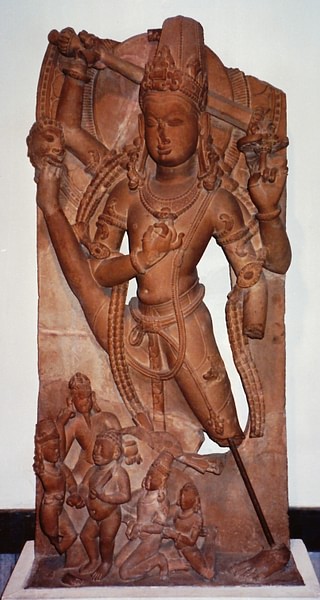
The sculpture of the period shows the warriors wearing their long hair in a huge bun at the back of the head, loose or in varying hairstyles, elaborately done. They are mostly bare above the waist, with a cloth band tied horizontally across the chest and tied in a knot at the front. The swords are of various shapes and sizes. Axes, bows, maces and spears were also used. Armours and possibly helmets were used by elites.
The constant losses of the Pratiharas against the Rashtrakutas showed that their reliance on the cavalry was not always worthwhile. The Rashtrakutas deployed superior strategies, and their emperors or princes who personally led the armies showed a vigour that their enemies could not match.
Legacy
Nagabhata I's efforts were crucial in checking the Arab invasion of India. The Pratiharas remained as strong bulwarks against the Arabs. They also made valuable contributions in the field of art, culture and commerce. The sculptural styles developed during the period were unique and remained an influence on later styles. The nagara style of Hindu temple architecture received a big boost under their rule. According to this style, the temple was built on a stone platform with steps leading up to it, with many regional variations. The highlight was a shikhara (a mountain-like spire on top, curving in shape). This style became very popular in northern India in the following centuries.





